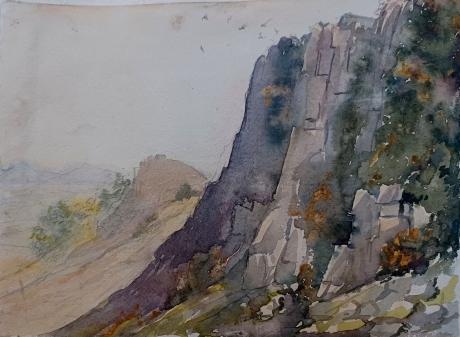inscribed "Spindlestone near Bamburgh" and inscribed with initials "LWT"
Tom and Laura Taylor and thence by descent
The Spindle Stone or Bridle Rock is a pillar of basalt standing out from the escarpment of the Great Whin Sill at Spindleton Heughs, west of Bamburgh. It is locally regarded as the rock over which Childy Wynde threw his horse's bridle before attacking the Laidl[e]y (loathsome) Worm (or dragon) - Northumberland’s version of Durham's better known, Lambton Worm
The Ballad of the Laidly Worm of Spindleston Heugh was said to have been written by the old mountain-bard, Duncan Frasier, living on Cheviot, A.D. 1270 and first printed from an ancient manuscript by the Rev. Robert Lambe, Vicar of Norham. It is thought most likely to have been written by the Rev. Lambe himself in the C18th.
In the Kingdom of Northumbria, a kindly king in Bamburgh Castle takes a beautiful but cruel witch as his queen after his wife's death. The King's son, Childe Wynd, has gone across the sea but the witch turns his sister, Princess Margaret, into a dragon. Later in the story, the prince returns and, instead of fighting the dragon, kisses it, restoring the princess to her natural form. He then turns the witch-queen into a toad and becomes king.
Spindlestone Heugh (or Heughs) is a dolerite crag on the Great Whin Sill escarpment in the parish of Easington, Northumberland. The Spindlestone itself is a natural stone column standing out from the crag, which is also known as "Bridle Rock". According to a local legend, Child Wynd threw his horse's bridle over the rock before tackling the worm. The ballad describes a cave and a stone trough used by the worm; a feature below the crag is marked "Laidley Worm's Trough" by the Ordnance Survey, but the nearby "Laidley Worm's Cave" was destroyed by quarrying in the 19th century.
The Laidly Worm of Spindleston Heugh, also known as The Laidly Worm of Bamborough, is a Northumbrian ballad about a princess who is changed into a dragon (the "laidly worm" of the title).
In the Kingdom of Northumbria, a kind king in Bamburgh Castle takes a beautiful but cruel witch as his queen after his wife's death. The King's son, Childe Wynd, has gone across the sea and the witch, jealous of the beauty of the king’s daughter, Princess Margaret, and quick to take advantage of Wynd’s absence, turns her into a dragon. The enchantment used is usually:
-
-
-
- I weird ye to be a Laidly Worm,
- And borrowed shall ye never be,
- Until Childe Wynd, the King's own son
- Come to the Heugh and thrice kiss thee;
- Until the world comes to an end,
- Borrowed shall ye never be.
-
-
Later in the story, the prince returns and, instead of fighting the dragon, kisses it, restoring the princess to her natural form. He then turns the witch-queen into a toad and becomes king.
The ballad was first published in 1778 in a compilation of folk songs. The ballad was said to have been transcribed by the Reverend Robert Lambe, the Vicar of Norham, from a manuscript "made by the old mountain-bard, Duncan Frasier, living on Cheviot, A.D. 1270", although it is probable that Lambe wrote it himself, drawing on local stories. In Joseph Jacob's version, the dragon Princess Margaret is appeased by putting aside seven cows for her per day. The prince, her brother, hears of it and comes for her despite his stepmother's attempt to keep him away.
The first studio recording of the ballad was sung by Owen Brannigan. The version sung was arranged by Vilém Tauský as an abridged narrative, having 10 verses as opposed to the original's 38 verses.
Laura Wilson Barker (6 March 1819 – 22 May 1905), was a composer, performer and artist, sometimes also referred to as Laura Barker, Laura W Taylor or "Mrs Tom Taylor".
She was born in Thirkleby, North Yorkshire, third daughter of a clergyman, the Rev. Thomas Barker. She studied privately with Cipriani Potter and became an accomplished pianist and violinist. As a young girl Barker performed with both Louis Spohr and Paganini. She began composing in the mid-1830s - her Seven Romances for voice and guitar were published in 1837. From around 1843 until 1855 she taught music at York School for the Blind. During this period some of her compositions - including a symphony in manuscript, on 19 April 1845 - were performed at York Choral Society concerts.
On 19 June 1855 she married the English dramatist, critic, biographer, public servant, and editor of Punch magazine Tom Taylor. Barker contributed music to at least one of her husband's plays, an overture and entr'acte to Joan of Arc (1871), and provided harmonisations as an appendix to his translation of Ballads and Songs of Brittany (1865).
Her other works include the cantata Enone (1850), the violin sonata A Country Walk (1860), theatre music for As You Like It, (April 1880), Songs of Youth (1884), string quartets, madrigals and solo songs. Her choral setting of Keats's A Prophecy, composed in 1850, was performed for the first time 49 years later at the Hovingham Festival in 1899. The composer was present.
Several of Barker's paintings hang at Smallhythe Place in Kent, Ellen Terry's house.
Barker lived with her husband and family at 84 Lavender Sweep, Battersea. There were two children: the artist John Wycliffe Taylor (1859–1925), and Laura Lucy Arnold Taylor (1863–1940). The Sunday musical soirees at the house attracted many well-known attendees, including Lewis Carroll, Charles Dickens, Henry Irving, Charles Reade, Alfred Tennyson, Ellen Terry and William Makepeace Thackeray.
Tom Taylor died suddenly at his home in 1880 at the age of 62. After his death, his widow retired to Porch House, Coleshill in Buckinghamshire, where she died on 22 May 1905, aged 86.

